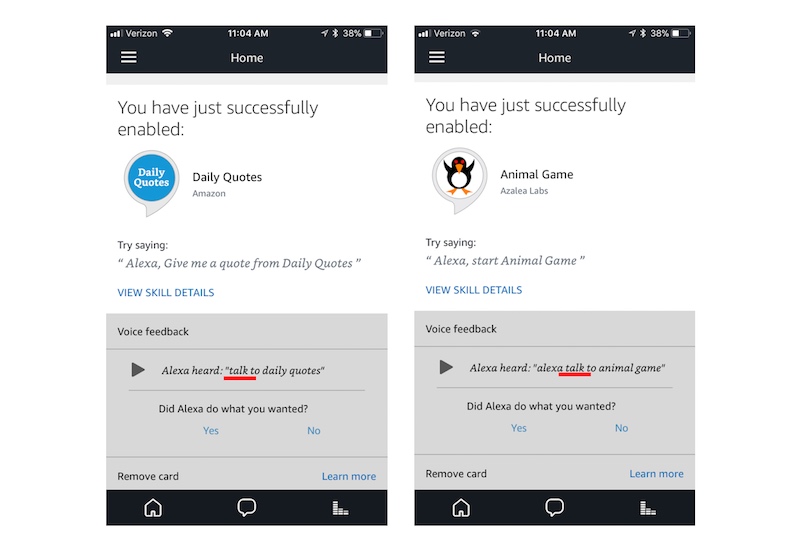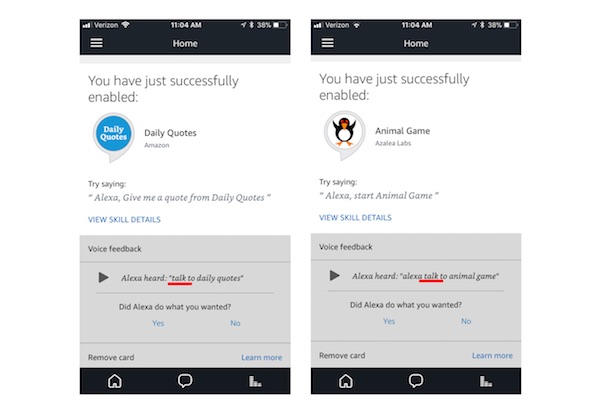Amazon is Experimenting with Alexa Skill Auto-Enablement

There is a key architectural difference between Amazon Alexa and Google Assistant that is often overlooked. Every third party Google Assistant app is available for anyone that asks for it by name. Users don’t have to do anything other than ask for the app. It’s like a webpage. If you know the URL, you can navigate directly to it.
Amazon has implemented a model more like mobile apps for third party Alexa skills. In the mobile world, you must download an app to use it. The Alexa model was designed to require users to enable skills–the voice equivalent of a download–in order to use them. However, Amazon appears to be experimenting with a hybrid model that includes Alexa skill auto-enablement.
Auto-Enablement isn’t Entirely New
Native or first party skills have always been auto-enabled. These are the Alexa skills developed and maintained by Amazon. Users have always had immediate access to timers, alarms, conversions and responses to questions for general information. Independently developed third-party skills face some friction in gaining users due to the enablement requirement. Typically, you cannot access a skill without first enabling it, even if you use the correct invocation phrase. That means there is a two-step process for consumers to access most third party Alexa skills. Although some high profile third party skills have occasionally been available without enablement, most common skills don’t have that benefit. That may be changing.
While working on another story I asked Alexa to “talk to Daily Quotes.” I was immediately delivered a Daily Quotes skill that is technically third party based on its listing, but Amazon is named as the publisher. Shortly after using the skill, I received a card in the Alexa app saying I had enabled it. Then I accessed another skill by saying, “Alexa, talk to Animal Game.” Again, I was taken right into a third party skill published by Azalea labs. Shortly thereafter I received cards saying I had enabled the Animal Game skill. Notice that my invocation phrase included “talk to” and not “enable.” I never asked for these skills to be enabled. It was done for me automatically.

This did not repeat for other skills that I tried yesterday. Many didn’t even result in a card being delivered even though I successfully engaged with the skill. However, I am aware of other skills that are auto-enabled by Alexa. The key finding here is that some skills have it and some don’t.
Both Models Have Merit, but the App Model Has More Friction
The app model introduces more friction in Alexa skill discovery, but it is not without merit. By allowing users to select skills to enable, the Alexa service is more likely to deliver the right skill when requested in the future. When you have more than 30,000 Alexa skills to navigate, many with the exact same name or similar sounding names, any assistance you can offer the AI to select the right skill can be helpful in delivering a consistent user experience. With that said, if the model didn’t have deficiencies, Amazon wouldn’t have to use the capability to selectively grant Alexa skill auto-enablement.
Amazon is dedicated to a great user experience and the targeted use of auto-enablement is likely designed with that goal in mind. Third party Alexa developers also want to deliver a great user experience, but can only do that if their skills can be discovered. Auto-enablement is one tool that can reduce skill discovery friction. It will be interesting to see if Amazon eventually develops a formal policy or offers developers guidance about it.
Video: Alexa Context Maintenance in Follow-Up Mode Delivers Improved Voice UX
What an Indie Developer Learned from Publishing Google Assistant Apps – Marcellus Pelcher









